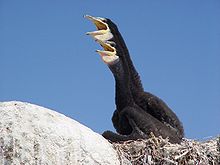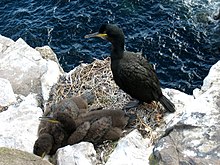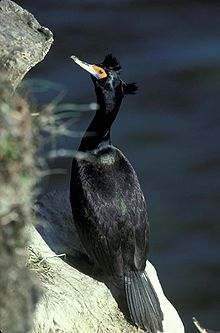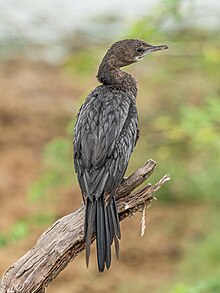Cormorants
| Cormorants | ||||||||||
|---|---|---|---|---|---|---|---|---|---|---|
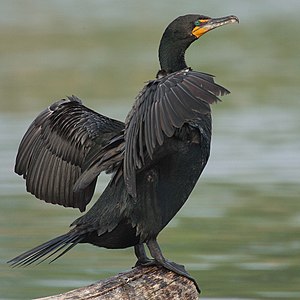
Ear scrap ( Phalacrocorax auritus ) |
||||||||||
| Systematics | ||||||||||
|
||||||||||
| Scientific name | ||||||||||
| Phalacrocoracidae | ||||||||||
| Reichenbach , 1849 |
The cormorants (Phalacrocoracidae) are a family of the order Suliformes . These are medium-sized to large water birds that breed in colonies and, according to various sources , are distributed worldwide with 26 to 43 species . If the birds wear feathers, they are referred to as "shags", otherwise as "cormorants", but this classification does not correspond to the actual relationships. Popularly these birds are also called "sea ravens", "sea ravens" or "water ravens"; the name cormorant is derived from the Latin "corvus marinus" ("sea raven").
features
Cormorants are medium to large, heavily built water birds. Their body length varies between 0.45 and 1.0 meters, their weight between 360 and 2800 grams (in the Galapagos shear up to 4000 grams). There are two types of coloration : A number of species are solid black or dark brown, with the plumage often having a metallic sheen , especially during the breeding season . With the second color variant, only the top is dark, but the bottom is white. Two-colored species are more common in the southern hemisphere, largely monochrome in the northern hemisphere. Sometimes both color variants occur within one species, for example the Ruffled Shear and the Stewart Shear , which each have one- and two-tone morphs . There is no conspicuous gender dimorphism ; however, males are on average larger and heavier than females.
In their youthful plumage, cormorants are gray-brown, although the underside can be a little paler. In two-colored species, even juvenile individuals show a corresponding distribution of lighter and darker shades of brown, which, however, are not yet so clearly separated from one another.
During the breeding season, the featherless areas of the skin on the throat and face as well as the beak often take on bright, usually red or orange colors. If there is a forelock or a bonnet, these are clearly elongated in the splendid dress , as are any decorative feathers on other parts of the body. In addition, the entire plumage color is often brighter and stronger.
Cormorants have a long neck and a rather long, wedge-shaped tail. Like all birds of the order Suliformes, they have an expandable throat pouch in which fish can be kept from swallowing. The beak is long, relatively high and sharply hooked at the tip. The nostrils are fused. The legs are set far back on the body and allow only a clumsy-looking, waddling or hopping gait on land. The feet are four-toed and webbed, as is typical of the Suliformes.
Cormorants move very neatly in the water, using their powerful feet as a drive. When diving, both legs are used simultaneously and in parallel as a paddle. The wings are usually placed close to the body. The tail serves as a rudder. The dense, less pneumatized skeleton is much heavier than that of the related pelicans . This reduces the lift . In this way, cormorants can reach greater depths quickly and with little expenditure of energy. Dives typically last 20 to 40 seconds. The longest secured dive time was 95 seconds for a common crow . The diving depths are very different for the species; many small species do not go deeper than 10 meters, while the Macquarie and the Paintbrush can dive up to 50 meters.
The wings are relatively short, slightly rounded and are usually strongly angled in the wrist when in flight. The wing beats are strong and stimulating; Cormorants can only circle and glide under favorable conditions. The flight speed can be up to 80 km / h. To fly up, cormorants have to walk a long distance over the surface of the water before they can take off. Landing is upright, with a fanned tail and feet outstretched. Cormorants also land skillfully on the ground, on branches or cliffs.
The wingspan of the airworthy species is 80 to 160 centimeters. One species, the Galapagos shear , is flightless; their wings are greatly reduced.
distribution and habitat
Cormorants are common on all continents except Antarctica . The greatest biodiversity is found in the tropics and the southern temperate zone. Cormorants are absent in Central and North Asia, in large parts of Canada and in large continental, arid regions.
Among the cormorants there are many endemic species that are found exclusively on small islands, including the Galapagos shear, the Socotra cormorant and the Chatham shear ; there are other examples on many sub-Antarctic islands . Other species, on the other hand, have extremely large areas of distribution, so the common cormorant is almost a cosmopolitan .
They can be found both on the coast of the sea and on inland waters. Some species live exclusively inland, others exclusively on coasts and others have populated both habitats equally. The coastal species are always found near the mainland and never on the open sea. In the interior, most species prefer flat areas; a notable exception here is the olive shot , which in the Andes even lives on lakes at an altitude of 5000 meters.
Most of the cormorants are resident birds , some are migratory birds and only a few are migratory birds . Especially the cormorants of the cold-temperate zones of the northern hemisphere often move southwards in winter; so the common cormorant is a partial migrant .
Way of life
Activity and comfort behavior
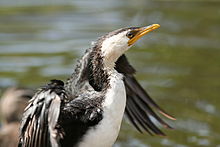
All cormorants are diurnal and only go into the water to look for food; In contrast to many other water birds, they do not rest on the water, but always on the land. Here they look for elevated places such as rocks, branches or fence posts, in the coastal species often also protrusions in steep cliffs; some species also rest on trees or power lines.
Cormorants regularly grease their plumage with the secretion of the rump gland . The popular claim that cormorants do not have a preen gland is untrue. However, due to their structure, the springs absorb water, which further reduces buoyancy.
When cormorants leave the water and find a resting place, they first shake their plumage. Then they spread their wings and sit motionless. While numerous theories were once devised as to the purpose of spreading the wings, experts today predominantly assume that it has the sole purpose of allowing the wet parts of the plumage to dry faster. Only in the species living in polar regions is this behavior not found, as it would lead to an excessive loss of body heat.
nutrition
The representatives of this family are primarily fish-eaters. Some species also feed on other aquatic animals such as cephalopods , snails , mussels , crustaceans and worms as well as (rarely) amphibians and reptiles. Only in the Heardscharbe do invertebrates make up the majority of the diet, all other species feed on fish for at least 50 percent, many even exclusively. Mostly small fish between 5 and 25 centimeters in length are caught, only rarely larger ones up to 60 centimeters. Indigestible parts such as bones and scales are gagged out as bulges once a day .
To hunt, cormorants dive straight down from the surface or with a small dive forward. The prey is then actively pursued, captured with the beak and brought to the surface. The fish is usually hunted alone, but some species (for example the black- faced shag ) are found in groups that circle the fish first.
Reproduction and development
Cormorants usually nest in colonies that can range in size from under 10 to hundreds of thousands of pairs depending on the species. The cormorants are often associated with other water birds such as gannets , herons or ibises , or with other types of cormorants. One brood takes place annually.
The nesting site is chosen by the male. This can be a protrusion of a cliff, a place on the seashore, in a tree or a shrub - the requirements vary from species to species. The male tries to attract a female with typical courtship gestures such as flapping wings or presenting the brightly colored throat. A female who joins the courting male is either scared away or accepted as a partner. Occasionally this is the same partner as in the previous year, but mostly the partner is changed annually.
The nest is built together. In some species it only consists of a hollow in the sand, gravel or guano . Most species, however, build a complex nest of branches or algae that are held together with mud or excrement . Sometimes the nest from the previous year is used again and can reach a considerable size due to the annual expansion. The immediate vicinity of the nest is defended against intruders; Since the nests in the large colonies are often very close, a bird only starts threatening gestures when another comes within range, i.e. can be reached from the nest with its head stretched out. Shaking the head with a stretched neck and an open beak is the typical threatening gesture; if this does not deter the intruder, he will be attacked with beak blows.
The female lays two to three (rarely four) eggs, which are incubated for 23 to 35 days. The boys are initially naked and helpless and only wear a downy dress after a week . They hatch at greater intervals; the most recently hatched young is usually not strong enough to assert itself against the older siblings when it comes to feeding and almost always dies after a few days. Even with three boys, often only the oldest gets through, although there can be rare cases in which all three can fledge. The young birds are initially fed with pre-digested and gagged liquid food. The parent birds work together to feed, further incubate and protect the young.
When the young are older, they put their heads into the adult bird's throat pouch themselves in order to get to the prey stored there. The young grow quickly and, depending on the species, fledge after 30 to 80 days; the average is 50 days. Once the young have left the nest, they usually gather in “kindergartens”. Here they will continue to be fed, which can take two to four months before they are completely independent.
The lifespan of cormorants is rarely more than ten to fifteen years, but the larger species have a potential maximum age of thirty years.
Tribal history
Fossil cormorants have been passed down since the Miocene (23.03 to 5.33 million years ago). The fossil species are very similar to the recent ones . For example, Nectornis miocaenus and Phalacrocorax littoralis have come down to us from the Miocene , both from Europe. From the Pliocene (5.33 to 1.8 million years ago) a species that is still alive today is known to be the common crow. The common cormorant has been known to be fossilized since the Pleistocene (1.8 million to 11,500 years ago).
Close relatives of the cormorants were the Plotopteridae , penguin-like birds that lived on the North Pacific coast from the Eocene (55.8 to 33.9 million years) to the Miocene.
Systematics
External system

The cormorants form a family within the Suliformes. The probable family relationships are given by the following cladogram :
|
|
|
|||||||||||||||||||||
|
|
The closest relatives of the cormorants are the darter , which some zoologists place as a subfamily of the cormorants. These are very similar to cormorants in terms of shape and, above all, in breeding biology, but differ from them in their extremely elongated neck and beak and a lurking fishing technique that is more reminiscent of that of the herons .
Internal system
Depending on the doctrine, the cormorant family includes between 26 and 43 species. In the case of many sub-Antarctic species in particular, it is often controversial whether they should be considered a species or a subspecies. Even according to the conservative view with 26 species, the cormorants would be the largest family of the Suliformes, which contains more than half of the species of this order. The following list shows the 41 species listed in the IOC World Bird List, which are currently assigned to three genera.
- Genus Leucocarbo (15 species)
- Blue-eyed shag ( Leucocarbo atriceps )
- Guanocormorant ( Leucocarbo bougainvillii )
- Antarctic shark ( Leucocarbo bransfieldensis )
- Campbell Shark ( Leucocarbo campbelli )
- Wart shag ( Leucocarbo carunculatus )
- Otagos Shark ( Leucocarbo chalconotus )
- Auckland shark ( Leucocarbo colensoi )
- South georgian shag ( Leucocarbo georgianus )
- Crozet's Scar ( Leucocarbo melanogenis )
- Heardscharbe ( Leucocarbo nivalis )
- Chatham shear ( Leucocarbo onslowi )
- Macquaries Shark ( Leucocarbo purpurascens )
- Bounty shear ( Leucocarbo ranfurlyi )
- † Leucocarbo septentrionalis
- Stewart's shard ( Leucocarbo stewarti )
- Kerguelenscharbe ( Leucocarbo verrucosus )
- Genus Microcarbo (5 species)
- Common Sedge ( Microcarbo africanus )
- Crown shard ( Microcarbo coronatus )
- Curled shear ( Microcarbo melanoleucos )
- Moorish shag ( Microcarbo niger )
- Dwarf shark ( Microcarbo pygmeus )
- Genus Phalacrocorax (21 species + 1 †)
- Common crow ( Phalacrocorax aristotelis )
- Ear scrap ( Phalacrocorax auritus )
- Olive shag ( Phalacrocorax brasilianus )
- Cape shark ( Phalacrocorax capensis )
- Japanese cormorant ( Phalacrocorax capillatus )
- Great cormorant ( Phalacrocorax carbo )
- Pittscharbe ( Phalacrocorax featherstoni )
- Black- faced pint ( Phalacrocorax fuscescens )
- Brown-cheeked shag ( Phalacrocorax fuscicollis )
- Buntscharbe ( Phalacrocorax gaimardi )
- Galapagos shear ( Phalacrocorax harrisi )
- White-breasted cormorant ( Phalacrocorax lucidus )
- Rock shark ( Phalacrocorax magellanicus )
- Sandfish ( Phalacrocorax neglectus )
- Socotra cormorant ( Phalacrocorax nigrogularis )
- Red Sea Shark ( Phalacrocorax pelagicus )
- Paintbrush pod ( Phalacrocorax penicillatus )
- † Spectacled cormorant ( Phalacrocorax perspicillatus )
- Spotted shag ( Phalacrocorax punctatus )
- Black Sharp ( Phalacrocorax sulcirostris )
- Red-faced pod ( Phalacrocorax urile )
- Magpie ( Phalacrocorax varius )
Humans and cormorants
use
The most important use is the breakdown of the cormorant dung , the guano , as a natural fertilizer ; the guanocormorant owes its name to this fact. Over the years, large colonies produce vast quantities of guano, which, since it consists of the remains of fish meals, is rich in elements such as nitrogen and phosphorus that are important for plant growth . The Inca and other South American peoples already used guano to increase the yield in agriculture. When the Spaniards took over, the Indian peoples' knowledge of natural resources was lost, and it was not until the 18th century that bird droppings were used again as fertilizer. In the middle of the 19th century, several million tons of guano were transported to Europe, especially from the west coast of South America. Not only cormorants, but also boobies and pelicans produced the valuable guano and were also victims of the intensive mining. Since not only the guano was recovered, but also eggs and birds were used to feed the workers, the stocks almost completely collapsed. From 1909 the uncontrolled mining of guano was stopped in Peru. The stocks were able to recover, especially after the demand for guano declined as a result of the development of ammonia synthesis by Fritz Haber in 1908, which created the basis for the industrial production of artificial fertilizers. Today, guano in Peru is only mined outside of the breeding season.
To a lesser extent, the mining of guano also played an economic role on the west coast of South Africa .
In the past, humans have made use of the fishing skills of the cormorant. In Europe, China and Japan, fishing was carried out with the help of cormorants (" cormorant fishing "). This traditional form of fishing can still be seen in Japan, where it is shown almost exclusively as a tourist attraction. A ring or ribbon is placed around the neck of the cormorant so that it cannot swallow the fish. After a few dives, the collar is removed to allow the birds to eat again.
Meat and eggs were mainly eaten by fishermen around the world. This use was in the foreground, especially in earlier centuries. The shag colonies on the coasts of New England and Newfoundland were used for this purpose by the settlers who lived there in the 17th century. The Eskimos use the hides of the sea shags to make clothes.
Threat and protection
In addition to the direct re-enactment by humans and the oil pollution of the seas, there are the following main causes of danger for the various species of cormorants: feral domestic animals that were introduced to islands that were previously free of predators and eat eggs and young animals; Aquatic poisoning with mercury , DDT and others; Fluctuations in ocean currents, El Niño phenomenon ; Overfishing of seas and inland waters and thus deprivation of the food base.
One species is already extinct: the spectacled cormorant was native to the Bering Island , perhaps also on neighboring islands and on the coast of Kamchatka . After seafarers had repeatedly collected the birds as travel provisions, the bird died out in 1850.
Many species of cormorants are listed as endangered by the IUCN . These are:
-
critically endangered ( critically endangered )
- Chatham shear; In 2003, only 270 pairs were counted, which is a dramatic drop compared to previous years
-
endangered (endangered)
- Pittscharbe
- Galapagos shard
- Shagfish
-
vulnerable (endangered)
- Campbell's Scar
- Warthog
- Stewart's scar
- Auckland shard
- Socotra cormorant
- Bounty Shear
The species listed as endangered have likely never had higher populations, but they live in extremely small ranges so a single local event like an oil spill could mean their doom.
The common cormorant is not endangered - its global population is estimated at 1 to 1.6 million specimens. After it had become relatively rare in Central Europe in the middle of the 20th century due to human stalking, its population figures have since recovered. Today fishermen in particular are demanding that the cormorants, which in their opinion have gained the upper hand, be shot down, since in the absence of natural predators, their unrestricted spread has an impact on fish stocks. This is not a purely European phenomenon - in North America similar demands are made for the species found there.
literature
- Josep del Hoyo and others: Ostrich to Ducks. Lynx, Barcelona 1992, ISBN 84-87334-10-5 ( Handbook of the Birds of the World. Volume 1).
- Bryan Nelson : Pelicans, Cormorants and Their Relatives. Oxford University Press, Oxford 2005, ISBN 0-19-857727-3 .
Individual evidence
Most of the information in this article has been taken from the sources given under literature; the following sources are also cited:
- ↑ Günther Drosdowski (arrangement): Duden Etymologie. Dictionary of origin of the German language. 2nd Edition. Dudenverlag, Mannheim 1989, ISBN 3-411-20907-0 , p. 378
- ↑ RM Sellers: Wing-spreading behavior of the cormorant Phalacrocorax carbo. In: Ardea. No. 83, 1995, pp. 27-36
- ↑ Jiri Mlikovsky: Cenozoic Birds of the World. Part 1, Europe. ( Memento of March 7, 2011 on WebCite ) (PDF file, approx. 2.6 MB) Ninox, Prague 2002, ISBN 8090110538
- ^ Brown, Joseph W. and John Harshman. 2008. Pelecaniformes. Version 27 June 2008 (under construction). http://tolweb.org/Pelecaniformes/57152/2008.06.27 in The Tree of Life Web Project
- ^ IOC World Bird List version 4.3: Hamerkop, Shoebill, pelicans, boobies & cormorants , accessed September 4, 2014
- ↑ Nicolas J. Rawlence, Charlotte E. Till, Luke J. Easton, Hamish G. Spencer, Rob Schuckard, David S. Melville, R. Paul Scofield, Alan JD Tennyson, Matt J. Rayner, Jonathan M. Waters, Martyn Kennedy : Speciation, range contraction and extinction in the endemic New Zealand King Shag complex. Molecular Phylogenetics and Evolution, August 2017, doi: 10.1016 / j.ympev.2017.07.011
- ↑ Nicolas J. Rawlence, R. Paul Scofield, Hamish G. Spencer, Chris Lalas, Luke J. Easton, Alan JD Tennyson, Mark Adams, Eric Pasquet, Cody Fraser, Jonathan M. Waters and Martyn Kennedy. 2016. Genetic and Morphological Evidence for Two Species of Leucocarbo Shag (Aves, Pelecaniformes, Phalacrocoracidae) from southern South Island of New Zealand. Zool. J. Linn. Soc. DOI: 10.1111 / zoj.12376
- ^ IUCN Red List
- ↑ Phalacrocorax carbo in the endangered Red List species the IUCN 2011. Posted by: BirdLife International, 2009. Accessed November 13, 2011th

